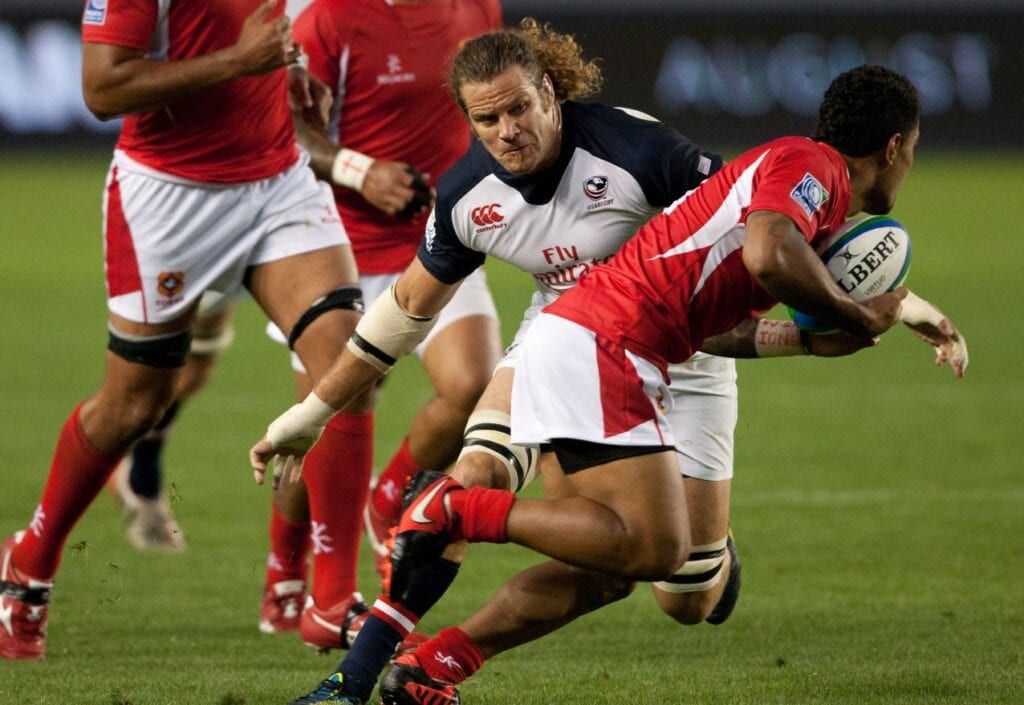
Press Release:
Rugby players continue to suffer from their high ‘injury load’ after retirement from the sport, according to the first independent study looking at the health of retired rugby players.
The researchers, led by Durham University’s sport and exercise scientists, are calling for governing bodies to step up efforts to prevent, in particular, recurrent injuries and ensure players are supported post-retirement.
Both elite and amateur rugby union and league players report suffering back pain and severe and regular joint pain which they attribute to the long-term impacts of their cumulative injuries post-retirement.
Concussion was the most common injury amongst rugby players with most suffering at least one concussion during their career and with this injury most associated with reported longer term impact.
Around half of all players had sustained a knee ligament injury with 25 per cent experiencing on-going problems.
Osteoarthritis – a condition that causes joints to become painful and stiff – was twice as common amongst elite rugby players compared to non-contact athletes and was associated with previous injuries and surgery.
The findings, published in the academic journal Sports Medicine, come after the Rugby World Cup in Japan saw a number of issues with high tackles and dangerous play leading to injuries.
Lead for the project, Dr Karen Hind from the Department of Sport and Exercise Sciences at Durham University, said: “It is clear from these findings that playing rugby union or rugby league is associated with lasting impacts in terms of injury and pain. Although there have been initiatives and rule changes to try and make the game safer, the rates of injury across a player’s entire career are still very high. The game is now also faster and players are bigger than they used to be so the impacts are greater.
“Many of the ex-players who took part in this study competed in rugby football over a decade ago when the sport was more about evasion. The injury levels for these individuals are up to nine-fold higher than for former non-contact athletes of a similar age.
“What we need to consider is that the game today is more about players running through opponents rather than evading – this is inevitably going to increase injury risk.”
The study was led by Durham University in collaboration with colleagues from Auckland University of Technology in New Zealand as part of the Global Rugby Health Research Network and the UK Rugby Health Project which built on the original New Zealand Rugby Health Study.
It compared the types and number of injuries suffered by 254 male elite rugby code players, amateur rugby code players and non-contact athletes, such as cricketers. The retired athletes ranged in age from 21 to 82 years.
Dr Hind added: “Our study looked at the total number of injuries across a player’s career and our findings suggest a need for better injury recovery given the reported frequency of recurrent injuries.
“A case could be argued for less players on the pitch and providing more opportunity for evasion. Medics also have a role to play in encouraging sensible injury recovery times which clubs need to support.
“Importantly, our findings highlight a need for programmes to support professional players post-retirement, in managing the long term impacts of injuries sustained during their career.”
Jon Sleightholme is a former international rugby player who represented England 12 times at senior level scoring four tries and was part of the team that won the Five Nations Championship in 1996. He also played for England Sevens and at club level for Wakefield, Bath and Northampton, retiring in 2004 after 13 seasons playing at the top level.
He commented: “The long term effects of playing contact sports especially at the elite level clearly have implications for players after their careers have finished. Sometimes those symptoms don’t appear until several years post-retirement.
“What the study highlights for me is the need for long term support and education for ex-players to help them manage these conditions as they get older.”
Dr Fraser Birrell, Consultant & Senior Lecturer in Rheumatology and Director of Science & Research for the British Society of Lifestyle Medicine (who was not involved in this research project), commented: “This is an important study that provides injury data on professional and amateur rugby players compared to non-contact athletes across an entire sporting career.
“We know how beneficial exercise is, but understanding the risks of high-intensity sport and especially the most frequent injury being concussion, helps inform playing guidelines and safety practices.
“It was striking to see that this high burden of injuries was associated with osteoarthritis at more than double the prevalence in professional rugby players (affecting half) compared to non-contact athletes, despite being younger.”
Professor Patria Hume, collaborator on the UK study and lead of the New Zealand study, commented: “The independent UK study has supported preliminary findings from our study in New Zealand, which was part funded by World Rugby, regarding increased concussions and injury during playing years and later osteoarthritis during retirement from sport.”
The UK Rugby Health Project includes ongoing studies investigating blood biomarkers, inflammation, head impacts, concussion and sub-concussions.
